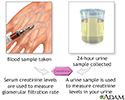Creatinine blood test
Serum creatinine; Kidney function - creatinine; Renal function - creatinine
The creatinine blood test measures the level of creatinine in the blood. This test is done to see how well your kidneys are working.
Creatinine in the urine can be measured with a urine test.
How the Test is Performed
How to Prepare for the Test
Your health care provider may tell you to temporarily stop taking certain medicines that can affect the test. These medicines include:
- Cimetidine, famotidine, and ranitidine
- Certain antibiotics, such as cefoxitin and trimethoprim
Tell your provider about all the medicines you take.
How the Test will Feel
When the needle is inserted to draw blood, some people feel moderate pain. Others feel only a prick or stinging sensation. Afterward, there may be some throbbing or slight bruising. This soon goes away.
Why the Test is Performed
Creatinine is a chemical waste product of creatine. Creatine is a chemical made by the body and is used to supply energy mainly to muscles.
This test is done to see how well your kidneys work. Creatinine is removed from the body entirely by the kidneys. If kidney function is not normal, the creatinine level in your blood will increase. This is because less creatinine is excreted through your urine.
Normal Results
A normal result is 0.7 to 1.3 mg/dL (61.9 to 114.9 µmol/L) for men and 0.6 to 1.1 mg/dL (53 to 97.2 µmol/L) for women.
Women often have a lower blood creatinine level than men. This is because women often have less muscle mass than men. Creatinine level varies based on a person's size and muscle mass.
The examples above are common measurements for results of these tests. Normal value ranges may vary slightly among different laboratories. Some labs use different measurements or test different samples. Talk to your provider about the meaning of your specific test results.
What Abnormal Results Mean
A higher than normal creatinine level may be due to:
- Blocked urinary tract
- Kidney problems, such as kidney damage or failure, infection, or reduced blood flow
- Loss of body fluid (dehydration)
- Muscle problems, such as breakdown of muscle fibers (rhabdomyolysis)
- Problems during pregnancy, such as seizures caused by eclampsia or high blood pressure caused by preeclampsia
A lower than normal creatinine level may be due to:
- Conditions involving the muscles and nerves that lead to decreased muscle mass
- Malnutrition
There are many other conditions for which the test may be ordered, such as high blood pressure, diabetes, or medicine overdose. Your provider will tell you more if needed.
Risks
There is little risk involved with having your blood taken. Veins and arteries vary in size from one person to another and from one side of the body to the other. Taking blood from some people may be more difficult than from others.
Other risks associated with having blood drawn are slight but may include:
- Excessive bleeding
- Fainting or feeling lightheaded
- Multiple punctures to locate veins
- Blood accumulating under the skin (hematoma)
- Infection (a slight risk any time the skin is broken)
References
Gharavi AG, Landry DW. Approach to the patient with renal disease. In: Goldman L, Cooney KA, eds. Goldman-Cecil Medicine. 27th ed. Philadelphia, PA: Elsevier; 2024:chap 106.
Oh MS, Briefel G, Pincus MR. Evaluation of renal function, water, electrolytes, and acid-base balance. In: McPherson RA, Pincus MR, eds. Henry's Clinical Diagnosis and Management by Laboratory Methods. 24th ed. Philadelphia, PA: Elsevier; 2022:chap 15.
Review Date: 8/20/2023








